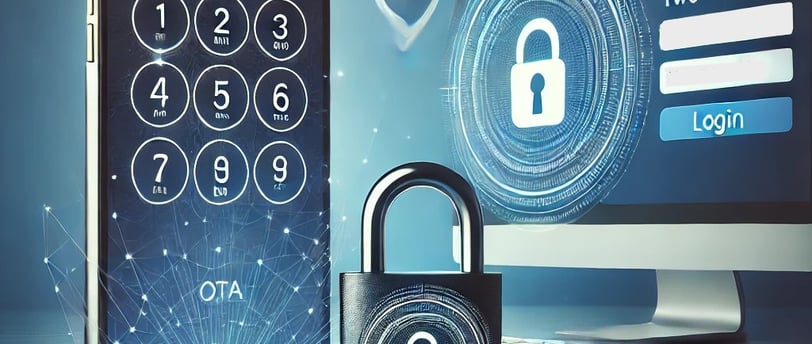Understanding and Implementing Two-Factor Authentication for Seniors
12/26/20247 min read


What is Two-Factor Authentication (2FA)?
Two-factor authentication, commonly referred to as 2FA, is a security process that enhances the traditional method of securing access to online accounts. Unlike standard authentication, which typically relies solely on a username and password, 2FA requires two different forms of verification to grant access. This method significantly reduces the likelihood of unauthorized access, adding an essential layer of protection against potential cyber threats.
The two elements involved in 2FA can generally be categorized into something you know and something you have. The first component is usually a password or personal identification number (PIN)—information that only the user should possess. The second component is typically a physical device or digital means, such as a smartphone app, text message, or email, that generates a unique code required for authentication. This multi-faceted approach helps ensure that even if a password is compromised, the account remains secure as long as the second factor is kept confidential.
Understanding the importance of two-factor authentication is crucial, especially for seniors who may be more vulnerable to phishing scams and identity theft. With 2FA in place, the chances of personal information being accessed without authorization are significantly diminished. Financial accounts, email services, and social media platforms all benefit from this added layer of security, as it acts as a formidable barrier against cyber intrusions. Creating awareness around the implementation of two-factor authentication can empower seniors to take charge of their online safety, ultimately protecting them from the risks associated with the increasing prevalence of digital threats.
Why is 2FA Important?
In today's digital landscape, online security has become a paramount concern for individuals across all age groups. However, seniors are particularly vulnerable to cyber threats, often being targeted by scams and hacking attempts. According to recent reports, seniors have seen a substantial increase in cyber crimes, with online fraud cases rising by over 60% in the past few years. This alarming trend underscores the necessity for robust security measures, among which two-factor authentication (2FA) plays a pivotal role.
Two-factor authentication provides an additional layer of security beyond the traditional username and password. Many seniors still rely solely on these passwords, which can be easily compromised through phishing attacks or data breaches. By implementing 2FA, users must provide a second form of verification, which could be a code sent via text message to their mobile phone or a confirmation from an authentication app. This process significantly reduces the chances of unauthorized access to personal accounts, making it more difficult for cybercriminals to infiltrate sensitive information.
Moreover, 2FA helps in fostering a sense of security among older adults, allowing them to engage more freely in online activities such as banking, shopping, or connecting with family members. It is worth noting that implementing 2FA can be a straightforward process yet offers profound security benefits. For seniors, who may lack familiarity with advanced security protocols, this method provides a practical solution to safeguard their digital identities. Consequently, understanding the importance of two-factor authentication is essential for seniors to protect themselves and navigate the increasingly complex online world with confidence.
Common Methods of 2FA
Two-factor authentication (2FA) enhances security by requiring not only a password but also a second piece of information. For seniors navigating this technology, understanding common methods used in two-factor authentication can facilitate smoother adoption and effective implementation.
One of the most widely recognized methods is the use of SMS codes. When logging into an account, a unique code is sent to the user’s mobile phone via text message. This code must then be entered in addition to the password to gain access. While convenient, it is essential to note that SMS codes can be vulnerable to interception, making them less secure than other options.
Authentication apps offer a more secure alternative. These apps, such as Google Authenticator or Authy, generate time-sensitive codes that are displayed within the application. To access an account, users simply enter the code shown in the app after inputting their password. This method is generally regarded as more secure than SMS since it does not rely on text messages that could be intercepted.
Hardware tokens represent another viable option for two-factor authentication. These are small physical devices that generate a unique code or use a USB connection to authenticate the user. While they require carrying an additional item, hardware tokens offer a high level of security and are particularly useful for sensitive transactions.
Lastly, biometric verification utilizes unique physical characteristics, such as fingerprints or facial recognition, to confirm a user’s identity. This method is quickly gaining popularity due to its ease of use. Seniors may find their smartphones already equipped with this feature, making it a seamless choice for two-factor authentication.
Each of these methods provides distinct advantages, and selecting the most comfortable option can empower seniors to protect their online accounts more effectively.
How to Set Up 2FA: A Step-by-Step Guide
Setting up two-factor authentication (2FA) can significantly bolster online security, especially for seniors. This guide will walk you through the process step-by-step, ensuring clarity and reducing potential confusion. While the specifics may vary slightly depending on the platform, the general principles remain consistent across email services, social media, and banking applications.
First, identify the platform you wish to secure. Most major services have 2FA options available. For instance, if you are starting with an email service like Gmail, sign in to your account and navigate to the security settings. Look for an option labeled "Two-Step Verification" or "Two-Factor Authentication." Here, you will typically find details on how to activate this security feature.
Once you’ve located the 2FA setting, click to begin the setup process. You will usually be prompted to choose your preferred second factor for authentication. This could be a text message sent to your mobile phone, a phone call, or an authenticator app like Google Authenticator or Authy. For seniors who may not have smartphones, utilizing text messages or phone calls may be the most straightforward approach.
After selecting your method, follow the provided instructions. If you chose text messages, enter your phone number and wait for a verification code to be sent. Input this code back into the platform to confirm that you have access to that phone. With authenticator apps, you will need to scan a QR code provided by the platform, which will subsequently link the app to your account.
Complete the setup by confirming the activation of 2FA. Some platforms allow you to generate backup codes in case you lose access to your phone. It is advisable to write these codes down and store them in a secure place. Following these steps will ensure that your accounts are better protected against unauthorized access.
Teaching 2FA to Seniors: Effective Strategies
Teaching two-factor authentication (2FA) to seniors requires a thoughtful approach that accommodates their unique learning styles and challenges. One of the most effective strategies is demonstrating patience throughout the learning process. Many seniors may feel overwhelmed or intimidated by technology, so it is essential to create a supportive environment. Using a calm and encouraging tone can help alleviate any anxieties while introducing the concept of 2FA.
Simplifying complex terms associated with two-factor authentication is crucial as well. Instead of technical jargon, it is recommended to use plain language. For example, instead of saying "authentication code," one can refer to it as a "security number" or "backup number" that enhances online security. By breaking down the terminology into simpler phrases, seniors can better grasp how 2FA protects their accounts and personal information.
Analogies can also serve as a powerful teaching tool. By relating 2FA to familiar situations in their daily lives, seniors can visualize the process more clearly. For instance, one could compare 2FA to a double-lock system, where a key and a combination are both required to access a safe. This analogy reinforces the importance of having an extra layer of security while making the concept relatable.
Moreover, providing hands-on assistance is invaluable when teaching 2FA. Engaging seniors in a practical manner allows them to apply their knowledge immediately. Conducting step-by-step demonstrations on setting up two-factor authentication on their devices or during online transactions can enhance their understanding. This hands-on experience not only boosts their confidence but also helps solidify the learning.
Finally, making the learning process engaging is key. Incorporating interactive elements, such as quizzes or group discussions, can motivate seniors to participate actively in the training. By utilizing these effective strategies, educators can facilitate a smoother learning experience for seniors, ensuring they understand and feel comfortable using two-factor authentication to secure their online activities.
Addressing Concerns and Misconceptions about 2FA
As technology continues to evolve, many seniors may encounter fears or misconceptions about two-factor authentication (2FA). A primary concern is often the complexity of how 2FA operates. Many may feel overwhelmed at the thought of integrating additional verification steps into their online activities, fearing that it could lead to complications or confusion. This apprehension can deter seniors from adopting valuable security measures that would protect their personal information.
Another common misunderstanding is related to the idea of forgetting codes or the possibility of losing access to authentication methods. Seniors might worry that they will forget the codes sent to their mobile devices or that they could misplace physical authentication tokens. To address this concern, it can be helpful to emphasize that many 2FA systems offer alternatives, such as recovery codes or backup authentication methods. Encouraging seniors to store these recovery codes in a secure and easily accessible location can mitigate feelings of anxiety surrounding potential mishaps.
Additionally, seniors may express fears about technology use itself, thinking they will face difficulties in accessing their personal accounts after implementing 2FA. Educators and family members can play a pivotal role by guiding them through the setup process. Creating a simple, straightforward guide detailing the steps to set up and utilize 2FA can empower seniors and alleviate their fears, making them feel more confident in using new technology. Regular practice and familiarization with the process can further strengthen their comfort level, leading to a more seamless experience when accessing accounts.
It is crucial to understand these concerns and provide reassurance. With adequate support and information, seniors can embrace two-factor authentication as a beneficial tool to enhance their online security.
Encouraging Regular Use of 2FA
Encouraging seniors to embrace two-factor authentication (2FA) as a regular security measure is paramount in an increasingly digital world. One effective strategy is to emphasize the importance of developing security habits. Seniors often prioritize familial communication and personal passions, but instilling the significance of safeguarding their digital lives can serve as a motivating factor. By highlighting the various threats they may face online, such as identity theft and phishing scams, seniors may become more inclined to incorporate 2FA into their everyday routines.
Sharing success stories can also play a pivotal role in building confidence in using two-factor authentication. When seniors hear about their peers who successfully thwarted potential cyber threats through the use of 2FA, it can inspire action. Whether through community newsletters, social media, or local groups, showcasing these positive experiences can create a sense of community among seniors. Knowing that others have protected their sensitive information using two-factor authentication fosters a belief that they too can do the same.
Setting reminders for the use of 2FA is another practical approach. This can be achieved by utilizing smartphone alerts or calendar notifications that prompt seniors to enable 2FA on various accounts. Regular reminders can help develop a habit, ensuring that security measures do not become an afterthought. Furthermore, ongoing support through workshops or help desks dedicated to technology can provide the necessary backing for seniors as they navigate their digital landscape. These support systems reassure them that they are not alone, fostering a willingness to master and regularly engage in the practice of two-factor authentication, ultimately strengthening their online security.
